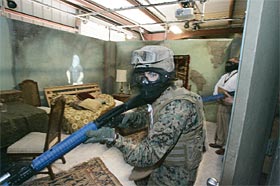Urban Warfare Simulator
BY Herschel SmithThe U.S. Marines have commissioned an Infantry Immersion Trainer system for the purpose of training in MOUT prior to deployment.

The Marine Corps is embracing breakthrough holographic technology to teach combat tactics and battlefield ethics at Camp Pendleton as troops there begin another major round of deployments to Iraq.
Marine officials yesterday unveiled the Infantry Immersion Trainer, a high-tech prototype simulator that resides in a former – and decidedly low-tech – tomato-packing plant that still bears directions for truck drivers.
Marines trained yesterday in Camp Pendleton’s high-tech prototype simulator, designed to evoke the conditions that U.S. troops face in Iraq.
The 32,000-square-foot, $2.5 million training ground became reality after a request from Gen. James Mattis, former commander of the 1st Marine Expeditionary Force at Camp Pendleton. The program capitalizes on 15 years of Navy and Marine research on everything from body movements to urban warfare, coupled with the latest advancements in simulation from defense companies such as Lockheed Martin.
The new training area is “a pretty big deal . . . that’s expected to save lives,” said Col. Clarke Lethin, chief of staff for the 1st Marine Expeditionary Force.
He added that it also could help guide Marines through the tough process of making split-second battle decisions involving morality and legality.
“As we go through the war, it’s changing out there. There are more no-shoots than shoots,” Lethin said. “We want to make sure that we are shooting the right people.”
It takes its inspiration from a city block in Iraq that U.S. troops typically would patrol, complete with a warren of shops and houses. Hardly a detail is overlooked among the props, modeled with Hollywood set-design techniques: Laundry hangs on the clotheslines. A grill sits against a wall. Propane tanks are placed here and there amid the musky scent of unpaved streets and alleys.
Perched in the rafters are projectors that cast life-size images of civilians and insurgents on wall after wall in the building. Live actors and pyrotechnics round out the integration of sight, sound and smell.
There is an argument to be made that this is two to three years later than needed. Additionally, the system isn’t perfect.
One of the Marines showing how the troops react in the various scenarios was Lance Cpl. Jason Trehan, a 24-year-old Ohio native who returned from his fourth Iraq assignment in November.
“It’s pretty realistic and a lot like what we do face,” Trehan said. “It could be bigger, though. Bigger is always better,” he said, in reference to the somewhat cramped series of rooms and low ceilings.
Trehan said a higher ceiling that would accommodate rooftops would more accurately depict a typical Iraqi village.
There is always justification for including Lance Corporals in the design review of all training and combat systems. Lance Corporals are the core of the Corps, but like our friends at OpFor, we are huge fans of General James Mattis, and this brainchild of Mattis will evolve.
Col. Lethin said the Camp Pendleton virtual trainer was in part the brainchild of Gen. James Mattis, who until recently was head of the I Marine Expeditionary Force and commander of Marine Corps Forces Central Command.
Mattis is now working with NATO and as head of the Joint Forces Command based at Norfolk, Va.
“General Mattis said that if we can train a pilot to fly a 747 in a simulator, we owe that same kind of training to our ground forces that are bearing the brunt of the casualties today,” Lethin said.
The local troops now deploying are finding a much more stable and calm environment in the former insurgent stronghold west of Baghdad along the Syrian and Jordanian border, Lethin said. But it remains a dangerous place.
“It’s a lot better today than it was, but there’s still bad guys to be killed,” Lethin said. “The training we now can offer here is good, but I want it to get even better.”
And get better it will. While no simulator can duplicate the reality of combat, all attempts to train warriors better should be met with appreciation as well as constructive criticism.





No comments yet.
RSS feed for comments on this post. TrackBack URL
Leave a comment